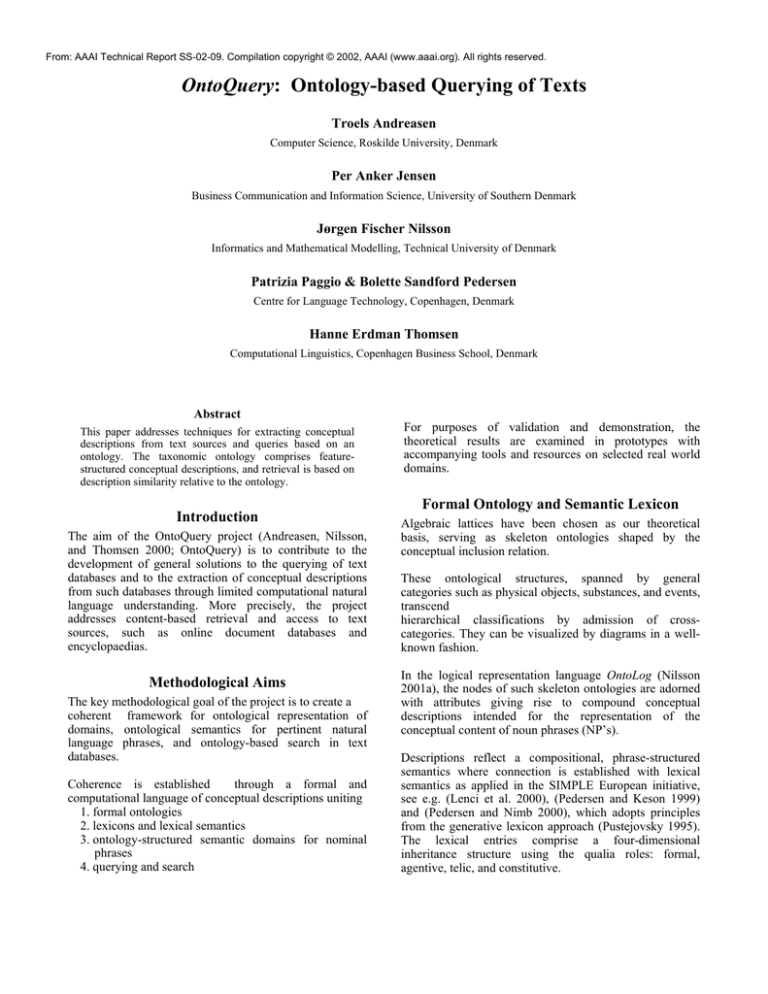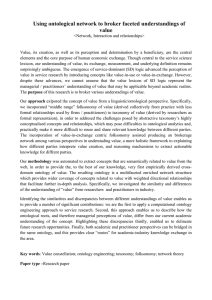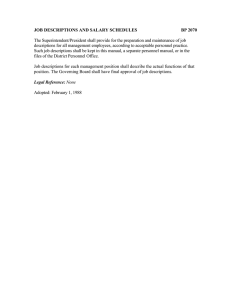
From: AAAI Technical Report SS-02-09. Compilation copyright © 2002, AAAI (www.aaai.org). All rights reserved.
OntoQuery: Ontology-based Querying of Texts
Troels Andreasen
Computer Science, Roskilde University, Denmark
Per Anker Jensen
Business Communication and Information Science, University of Southern Denmark
Jørgen Fischer Nilsson
Informatics and Mathematical Modelling, Technical University of Denmark
Patrizia Paggio & Bolette Sandford Pedersen
Centre for Language Technology, Copenhagen, Denmark
Hanne Erdman Thomsen
Computational Linguistics, Copenhagen Business School, Denmark
Abstract
This paper addresses techniques for extracting conceptual
descriptions from text sources and queries based on an
ontology. The taxonomic ontology comprises featurestructured conceptual descriptions, and retrieval is based on
description similarity relative to the ontology.
Introduction
The aim of the OntoQuery project (Andreasen, Nilsson,
and Thomsen 2000; OntoQuery) is to contribute to the
development of general solutions to the querying of text
databases and to the extraction of conceptual descriptions
from such databases through limited computational natural
language understanding. More precisely, the project
addresses content-based retrieval and access to text
sources, such as online document databases and
encyclopaedias.
Methodological Aims
The key methodological goal of the project is to create a
coherent framework for ontological representation of
domains, ontological semantics for pertinent natural
language phrases, and ontology-based search in text
databases.
Coherence is established
through a formal and
computational language of conceptual descriptions uniting
1. formal ontologies
2. lexicons and lexical semantics
3. ontology-structured semantic domains for nominal
phrases
4. querying and search
For purposes of validation and demonstration, the
theoretical results are examined in prototypes with
accompanying tools and resources on selected real world
domains.
Formal Ontology and Semantic Lexicon
Algebraic lattices have been chosen as our theoretical
basis, serving as skeleton ontologies shaped by the
conceptual inclusion relation.
These ontological structures, spanned by general
categories such as physical objects, substances, and events,
transcend
hierarchical classifications by admission of crosscategories. They can be visualized by diagrams in a wellknown fashion.
In the logical representation language OntoLog (Nilsson
2001a), the nodes of such skeleton ontologies are adorned
with attributes giving rise to compound conceptual
descriptions intended for the representation of the
conceptual content of noun phrases (NP’s).
Descriptions reflect a compositional, phrase-structured
semantics where connection is established with lexical
semantics as applied in the SIMPLE European initiative,
see e.g. (Lenci et al. 2000), (Pedersen and Keson 1999)
and (Pedersen and Nimb 2000), which adopts principles
from the generative lexicon approach (Pustejovsky 1995).
The lexical entries comprise a four-dimensional
inheritance structure using the qualia roles: formal,
agentive, telic, and constitutive.
The project incorporates the Danish SIMPLE lexicon,
which consists of 10,000 Danish sense descriptions
extended in the OntoQuery project with 1,000 domainspecific concept descriptions within the nutrition domain.
All terms have been extracted from about one hundred
articles on nutrition from The Danish National
Encyclopaedia.
Conceptual Descriptors
The descriptors appearing as nodes in the formal ontology
are to represent the conceptual content of nominal phrases
comprising nouns (including noun-noun compounds,
which abound in Danish), adjectives, and prepositional
phrases. The determiner structure is ignored as it is
considered irrelevant to the conceptual content of the
phrase. Nominal phrases are identified using preprocessing
techniques such as POS-tagging and NP recognition (cf.
Paggio et al. 2001).
Formally, the representations are akin to the (typed)
feature structures commonly applied in unification-based
parser systems, e.g. the LKB system (cf. http://wwwcsli.stanford.edu/~aac/lkb.html). However, the attributes
applied in this project express ontological relationships
such as parthood, causality etc., rather than syntactic or
functional relations.
For instance, the descriptor corresponding to the NP
fedtdepoter hos børn (fat deposits in children) is the
complex descriptor resulting from the combination of the
atomic descriptor ‘deposit’ with the descriptors ‘fat’ and
‘child’ by means of the relations CON (contains) and LOC
(located-in). The descriptor is shown in (1) below.
(1) deposit
CON : fat
LOC : child
Another example is the descriptor in (2), which
corresponds to the NP behandling af børn med overvægt
(treatment of children affected by obesity), as well as to its
paraphrases, e.g. behandling af overvægtige børn
(treatment of obese children). Here the relations considered
are PNT (patient) and CHR (characteristic).
(2) treatment [PNT: child [CHR: obesity]]
From a logical point of view descriptors are algebraic
terms in a relational logic resembling description logic, but
with a stronger bias on the taxonomic lattice structure.
Ontological Grammar
A logically simplified and computationally more
manageable version of the logico-algebraic representation
framework is achieved by letting the ontology with
accompanying descriptions be specified and generated by a
BNF-grammar (Nilsson 2001b). This gives rise to the
notion of ontological grammar supporting generative
ontologies with an infinitude of descriptions through
recursive definitions of categories. In such grammars the
syntactic derivation relation mediates the conceptual
specialization relation.
An ontological grammar specifies semantic target domains
for the considered linguistic phrases, enforcing ontological
combinability restrictions, which assist in the
disambiguation of the linguistic phrases. The descriptors
are produced by the ontological grammar.
By way of illustration, the Danish NP behandling af børn
med overvægt considered above is ambiguous between the
reading given in (2) and the instrumental reading
represented by the descriptor in (3), where BMO
abbreviates ‘by means of’:
(3) treatment
PNT : child
BMO : obesity
While the reading in (2) is supported by a rule allowing
physical properties, in casu ‘obesity’, to be attached to
physical objects, in casu ‘child’, the reading in (3) is
rejected on ontological grounds, since ‘obesity’ is a
‘property’, which cannot serve as an ‘instrument’, and in
the ontological grammar rules, ‘property’ is excluded as a
possible ontological argument type for the BMO-relation.
Querying
The basis for querying and search is the evaluation of
similarity between descriptions (collections of descriptors)
from text sources in the database and the description of the
query phrase. Given a query, retrieval of relevant text parts
is achieved via the ontology with retro-links from
descriptors into the text sources in the database.
The comparison of descriptors is not merely syntactic.
Rather, their resemblance is measured in terms of
similarity derived from concept relations in the ontology.
Similarity between the descriptors, as situated in the
ontology, is thus obtained from engaging ontological
reasoning capabilities.
The texts in the database have descriptions attached.
Descriptions are defined as sets of sets of descriptors and
are derived at the level of sentences. Initially, in the
processing of a query, a description is generated. Then this
query description is compared, in principle, to every
description of every sentence in every document appearing
in the database. Finally, sentences in the documents in the
database are ranked by the degree to which their
description resembles the description of the query. The
query answer is a ranking of the sentences that are most
similar to the query.
As mentioned briefly above, descriptors are managed and
compared in structures called descriptions, which have the
form:
D = {D1 , …, Dn } = {{D11 , …, D1m1 }, …, {Dn1 , …, Dnm n }}
where each Di is a set of descriptors Dij, j=1,…,mi. Each Di
corresponds to an NP in the text described, and, as it
appears, it may embed one or more descriptors.
Descriptions are not unique and may vary by level of detail
and combinability. Among the possible descriptions for the
phrase: Alternativ medicin og behandling af børn med
overvægt (alternative medicine and treatment of children
affected by obesity) are the following increasingly accurate
descriptions:
(4)
{{alternative},{medicine},{treatment},{child},{obesity}}
(5)
{{alternative, medicine},{treatment},{child, obesity}}
(6)
{{medicine [CHR: alternative]},
{treatment [PNT: child [CHR: obesity]]}}
The principle applied for comparison of descriptions is a
fuzzy nested aggregation combining descriptor similarity
into similarity of full description structures. Descriptor
similarity is derived from concept relations in the ontology,
for instance based on distances measured over the shortest
paths of reasoning. This principle is described in more
detail in (Andreasen 2001).
Descriptions for each sentence in the database are
compiled and stored in the database, and, furthermore, all
compound descriptors in database descriptions are, in
principle, expanded to cover also subsuming concepts. For
instance, the element
(7) {treatment [PNT: child [CHR: obesity]]}
may be expanded to the set
(8) {treatment, treatment [PNT: child],
treatment [PNT: child [CHR: obesity]]}
thereby including subsuming concepts. Assuming a
disjunctive interpretation, this means that the database
object described by (7) is considered a good candidate
answer object for a query on, e.g., ‘treatment’. A specific
answer to a general query is useful, while the opposite is
typically not the case.
Finally, the evaluation is initiated with an expansion of the
query to include similar descriptors as alternatives. Thus, if
the ontology includes ‘obesity ISA disorder’, then the term
‘disorder’ may be replaced by e.g. the fuzzy set of terms
‘1/disorder + 0.9/obesity’, indicating that ‘disorder’
matches fully while ‘obesity’ matches to some degree.
Challenge Questions
The project is currently developing an ontological
grammar for the domain of nutrition. One of the
challenges to be faced is how to extend this grammar to
other technical and scientific domains, while retaining the
disambiguating power of the ontological grammar.
Adjustment to new domains further requires that
appropriate domain ontologies are made available. Thus,
research in automatic term extraction and ontology
building are relevant to the OntoQuery project.
Whenever new material is added to the text database, the
new texts have to be processed for the purpose of
generating descriptors. Unknown words are treated as
descriptors denoting concepts per se, but their position in
the ontology is unknown, and thus synonymy, hyponymy
etc., are disregarded. The project addresses querying of
Danish text databases, but few resources such as lexicons
and grammars exist for this language. Therefore, to make
the system perform better on unknown material and new
domains, larger ontology-based lexicons for Danish are
needed.
Acknowledgments
The project is funded in part by the Danish Research
Councils under the interdisciplinary Informatics
Programme from 1999 through 2004.
References
Andreasen, T; Nilsson, J. Fischer; and Thomsen, H.
Erdman 2000. Ontology-based Querying. In Flexible
Query Answering Systems, Recent Advances, 15-26.
Physica-Verlag, Springer.
Andreasen, T. 2001a. Query evaluation based on domainspecific ontologies. In NAFIPS'2001, 20th IFSA / NAFIPS
International Conference Fuzziness and Soft Computing,
1844-1849, Vancouver, Canada.
Lenci, A.; Bel, N; Busa, F; Calzolari, N; Gola, E;
Monachini, M; Ogonowski, A; Peters, I; Peters, W.;
Ruimy, N.; Villegas, M.; and Zampolli, A. 2000. SIMPLE:
A general Framework for the Development of Multilingual
Lexicons. International Journal of Lexicography 13(4),
Oxford University Press, Oxford.
Nilsson, J. Fischer 2001a. A Logico-Algebraic Framework
for Ontologies ONTOLOG. In Jensen; P. Anker, and
Skadhauge, P. eds. Proceedings of the First International
OntoQuery Workshop Ontology-based interpretation of
NP's. 11-42. Department of Business Communication and
Information Science, University of Southern Denmark,
Kolding.
Nilsson, J. Fischer 2001b. Concept Descriptions for Text
Search, In Proceedings from the 11th European-Japanese
Conference on Information Modelling and Knowledge
Bases. 284-288. Maribor, Slovenia. Forthcoming in
Information Modelling and Knowledge Bases, IOS press.
OntoQuery. Project web site: http://www.ontoquery.dk
Paggio, P; Pedersen, B.S.; and Haltrup, D. 2001. Applying
Language Technology to Content-based Querying – The
Ontoquery Project, in Proceedings from Workshop on
Artificial Intelligence for Cultural Heritage and Digital
Libraries. 75-79. Università di Bari, Italy.
Pedersen, B.S., and Keson, B. 1999. SIMPLE - Semantic
Information for Multifunctional Plurilingual Lexica: Some
Danish Examples on Concrete Nouns, in: SIGLEX99:
Standardizing Lexical Resources, Association of
Computational Linguistics, ACL99 Workshop, Maryland.
Pedersen, B. S., and Nimb, S. 2000. Semantic Encoding of
Danish Verbs in SIMPLE - Adapting a verb-framed model
to a satellite-framed language. In Proceedings from the
Second International Conference on Language Resources
and Evaluation, LREC 2000, Athens.
Pustejovsky, J. 1995. The Generative Lexicon. MIT press.




